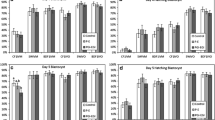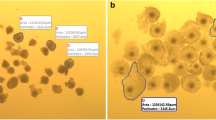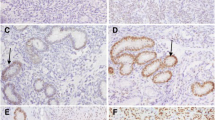Abstract
Purpose
Our purpose was to assess the role of platelet activating factor (PAF) in embryo implantation, we examined the effects of PAF and a PAF antagonist on the in vitro implantation of mouse embryos, using an in vitro embryo culture system in the absence of the endometrium.
Methods
BDF1 mouse pronuclear-stage embryos were cultured until they developed to the two-cell, the four- to eight-cell, or the morula stage in the absence of PAF or its antagonist CV6209. The medium was then changed and supplemented with PAF or CV6209 at various concentrations. We also examined the reversible effects of PAF addition to the media containing the PAF antagonist.
Results
The addition of PAF to the culture from the two-cell stage significantly (P <0.05) increased the rates of embryo implantation in vitro (control, 69.8%; 10 −10 MPAF, 90.1%; 10 −9 MPAF, 95.5%). Similarly, the addition of PAF to the cultures from the four- to eight-cell and morula stage also significantly (P <0.05) increased their rates of implantation in vitro. In contrast, the addition of CV6209 to the culture significantly (P <0.01) decreased the rates of embryo implantation in vitro. CV6209 also decreased the rate of blastocyst formation. The degree of inhibition by CV6209 decreased with the advancing stage of embryos. The addition of PAF to media containing CV6209 reversed the inhibition and restored the implantation rate in vitro.
Conclusions
These results suggest that PAF may act directly on the mouse embryo and favor its implantation like an autocrine activating factor, irrespective of the presence or absence of the endometrium.
Similar content being viewed by others
References
O'Neill C: Thrombocytopenia is an initial maternal response to fertilization in mice. J Reprod Fertil 1985;73:559–566
O'Neill C: Examination of the causes of early pregnancy-associated thrombocytopenia in mice. J Reprod Fertil 1985;73:567–577
O'Neill C: Partial characterization of the embryo-derived platelet-activating factor in mice. J Reprod Fertil 1985;75:375–380
O'Neill C: Embryo-derived platelet-activating factor: A preimplantation embryo mediator of maternal recognition of pregnancy. Dornest Anim Endocrinol 1987;4:69–85
Cllier M, O'Neill C, Ammit AJ, Saunders DM: Biochemical and pharmacological characterization of human embryoderived platelet activating factor. Hum Reprod 1988;3:993–998
Morton H, Hegh V, Clunie GJA: Immuno-suppression detected in pregnant mice by rosette inhibition test. Nature 1974;249:459–460
Orozco C, Perkins T, Clarke FM: Platelet-activating factor induces the expression of early pregnancy factor activity in female mice. J Reprod Fertil 1986;78:549–555
Sueoka K, Dharmarajan AM, Miyazaki T, Atlas SJ, Wallach EE: Platelet-activating factor induced early pregnancy factor activity from the perfused rabbit ovary and oviduct. Am J Obstet Gynecol 1988;159:1580–1584
Spinks NR, O'Neill C: Embryo-derived platelet-activating factor is essential for establishment of pregnancy in the mouse. Lancet 1987;1:106–107
Spinks NR, O'Neill C: Antagonists of embryo-derived platelet-activating factor prevent implantation of mouse embryos. J Reprod Fertil 1988;84:89–98
Acker G, Hecquet F, Etienne A, Braquest P Mencia-Huerta JM: Role of platelet-activating factor (PAF) in the ovoimplantation in the rat: Effect of the specific PAF-acether antagonist, BN 52021. Prostaglandins 1988;35:233–241
Acker G, Braquest P Mencia-Huerta JM: Role of plateletactivating factor (PAF) in the initiation of the decidual reaction in the rat. J Reprod Fertil 1989;85:623–629
Ryan JP, Spinks NR, O'Neill C, Ammit AJ, Wales RG: Platelet activating factor (PAF) production by mouse embryos in vitro and its effect on embryonic metabolism. J Cell Biochem 1989;40:387–395
Ryan JP, O'Neill C, Wales RG: Oxidative metabolism of energy substrates by preimplantation mouse embryos in the presence of platelet-activating factor. J Reprod Fertil 1990;89:301–307
Ryan JP, Spinks NR, O'Neill C, Wales RG: Implantation potential and fetal viability of mouse embryos cultured in media supplemented with platelet-activating factor. J Reprod Fertil 1990;89:309–315
Spinks NR, Ryan JP, O'Neill C: Antagonists of embryoderived platelet-activating factor act by inhibiting the ability of the mouse embryo to implant. J Reprod Fertil 1990;88:241–248
Author information
Authors and Affiliations
Rights and permissions
About this article
Cite this article
Nishi, O., Tominaga, T., Goto, Y. et al. Effects of platelet activating factor on mouse embryo implantation in vitro. J Assist Reprod Genet 12, 330–334 (1995). https://doi.org/10.1007/BF02213714
Received:
Accepted:
Issue Date:
DOI: https://doi.org/10.1007/BF02213714




